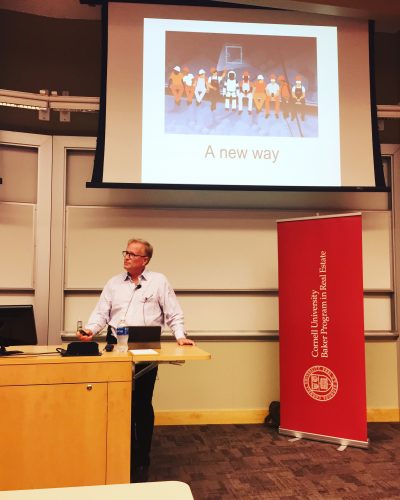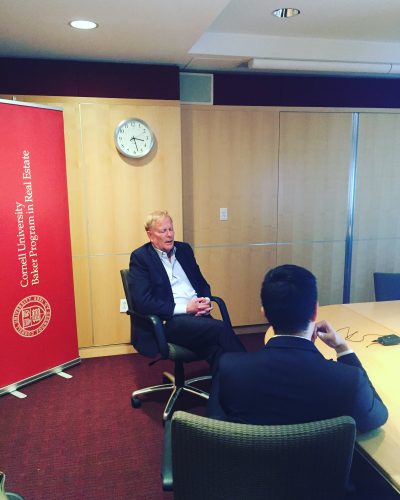
On October 5, Cornell’s Baker Program in Real Estate had the pleasure of hosting Don Reid, Executive Vice President of Strategy at Sustainable Living Innovations (SLI). Mr. Reid has an extensive history in finance with years of experience in energy and power (including renewables), infrastructure, and real estate. He was former co-head of Morgan Stanley’s global investment banking energy business unit. Prior to Morgan Stanley, Mr. Reid spent ten-years with Goldman Sachs. He is also on several boards including a private metallurgical coal corporation and a helium extractor company. He also served as a board member of a ground-mount solar developer. A true international citizen, Mr. Reid holds British, US, and Canadian citizenships.
SLI is currently paving its own unique path in the development world, particularly in the arena of multi-family high-rise building technology. Manufactured systems for some might be synonymous with prefabrication or modular construction which may conjure less desirable living environments such as limited customization and space. On the contrary, Mr. Reid introduced students to the breakthrough technologies in manufactured systems that are allowing SLI to build luxury high-rise residences of varying size, floorplans, and personalized amenities. Even more astounding, SLI’s panel-based building structure cuts down site-work by 75-80% and building schedules by more than 50%. With nearly a dozen patents pending in the US, SLI is seeking to be the next disruptor in the architectural and development world.
Mr. Reid emphasized one main question he always asks as part of the SLI executive team. “Can we do better?” For Mr. Reid this meant asking if there were ways to dramatically improve quality of life in a building while lowering operating costs. His answer is a resounding yes. Not only do SLI’s buildings significantly shave down construction time, but also provide more sustainable and energy-saving solutions in the building process. The average weight per square foot of an SLI building is 25 pounds compared to the 85-150 pounds / square foot weight of a traditionally-built residential high-rise. This considerable reduction in weight is due to the near concrete-free design model of SLI buildings. The minimal use of concrete heavily reduces the carbon footprint of SLI’s construction by more than two-thirds compared to similar projects utilizing traditional methods. Included in the designs are also specially infused energy-saving measures that range from hydronic heating to solar energy, dramatically cutting costs to the tune of 73% over 24 months for residents.
During his presentation Mr. Reid shared the fundamental building process behind SLI’s manufactured system: the panel. Unlike many modular construction designs that consist of ready-made conjoined floor, wall, and ceiling units, SLI utilizes a special panel system where each panel is specifically designed, pre-wired, and shipped flat to the construction site. These panels are the building-blocks of each individual unit, creating substantial room for customization. Consumers are taking notice. For example, a 24-unit six-story SLI project in Seattle’s university district was originally expected to rent for $1500/month per unit with a three month timeline for complete occupancy. Instead, it was fully rented out in two weeks at $1950/month per unit.

According to Mr. Reid, SLI’s manufactured building technology is not only bringing change to the architecture and development industry, but also the world of construction financing. Unlike traditional construction projects, SLI’s pre-manufactured process is able to enjoy a fixed price on the cost of construction since nearly all parts are created before building assembly begins. It also has the unique benefit of a fixed construction/assembly time. With both a compressed design and construction phase and lower hard and soft costs, SLI is able to reduce its contingency fee in construction by 15-20%. This building process also eliminates delay time especially from late contractors and subcontractors which add up considerably in the life of a large construction project. With the significantly reduced construction time and added accuracy of the project completion schedule, financing resembles more of a WIP funding than a traditional construction loan.
These are certainly not the manufactured homes of yesterday but advanced, sustainable, high-rise buildings in the heart of some of the country’s busiest cities. In an industry where disruption is not always a buzzword, Mr. Reid gave students a clear example of how large-scale change is a real possibility. During my interview with Mr. Reid, he gave one key advice to students, “Always be curious.” Sage instruction for aspiring leaders in real estate. Students of the Baker Program were honored to host Mr. Reid at Cornell University and thank him for providing an inside-look into a rapidly advancing industry fusing technology and real estate.
